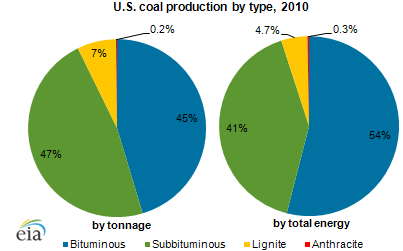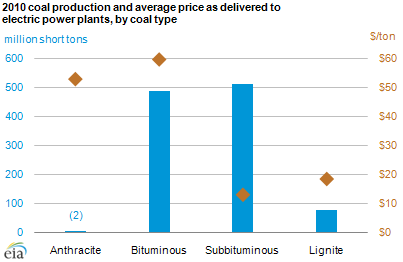
Subbituminous and bituminous coal dominate U.S. coal production

Note: Total energy estimated utilizing 2009 energy density values.
Download CSV Data
While almost all coal consumed in the United States is used to generate electricity (90% in 2010), coal is not entirely homogeneous. Coal is classified into four types, distinguished by the amount of heat it produces and, for coking coal, its ability to agglomerate. While coal with higher levels of heat content, coking characteristics, and lower sulfur levels is typically more valuable, other factors such as location and supply and demand play a significant role.
Major coal types include:
Subbituminous: Generally used for electricity generation, subbituminous coal contains 35% to 45% carbon. A major component of U.S. coal production, subbituminous coal makes up 47% of U.S. coal production by weight and 41% by energy intensity. Although subbituminous coal has the second lowest energy content, large quantities are found in thick beds near the surface, resulting in low mining cost and, correspondingly, lower prices. Wyoming produces the vast majority of subbituminous coal in the U.S.
Bituminous: Containing the widest range of carbon content (45% to 86%), bituminous is mainly used as a fuel to generate electricity, though some is used as coking coal to produce steel. The oldest and most abundant coal type found in the United States, bituminous coal makes up 45% of U.S. coal production by weight and 54% by energy intensity. West Virginia leads production, followed by Kentucky and Pennsylvania.
Lignite: Lignite has the lowest energy content of the four types. It is used in electricity generation and comprises 7% of U.S. coal production by weight and 5% by energy intensity. Lignite coal is typically comprised of coal deposits which have had the least amount of heat, pressure, and time to develop. As a result, lignite has a low carbon content (25% to 35%). Texas and North Dakota are the main producers of lignite.
Anthracite: Anthracite has the highest carbon content (86% to 97%). Rare in the U.S., it comprises only 0.2% of total coal production. All the anthracite mines in the U.S. are located in northeast Pennsylvania.

Download CSV Data